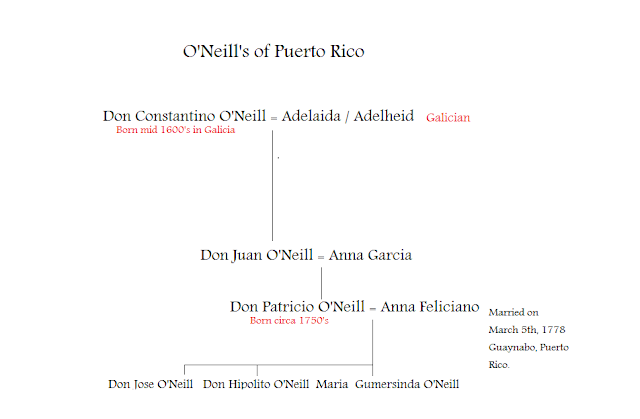You have certain O’Neill families in Puerto Rico that their
origins are not known at all, since they have not taken time to do the
genealogical research, or care about a y-dna test. At one time before I came
along all the O’Neill’s in Puerto Rico believed to be related or share a common
ancestor, but the facts are another proven by extensive genealogical research
and y-dna test.
I have seen that there are still those O’Neill’s in Puerto Rico
who believe that they were part of the Irish Potato famine. That is nonsense
this event happened in Ireland during 1842 to 1852, and it caused a mass immigration
of Irish to the United States, Australia, Canada, and England, and not to
Puerto Rico. Puerto Rico was part of the Spanish Crown and emigration to the
island was only allowed by Spain. There were only two recorded O’Neill’s to
have arrived in Puerto Rico with unknown origins after the 1800’s, and this was
during the Royal Decree of the Graces in 1815.
The origin of the O’Neill’s of Puerto Rico varies on the
specific families.
1.
The O’Neill’s of the Fews who lived in Rio Piedras,
Guaynabo, and San Juan. These were the children of Don Arturo O’Neill of the
Fews 2nd Marques del Norte, and he arrived in Puerto Rico in the
early 1800’s, but before that his uncles Don Niall “ Nicolas” O’Neill, Don
Enrique O’Neill , and Don Arturo O’Neill 1st Marquez del Norte were
involved in the island.
2.
The descendants of Don Juan O’Neill are well
established with a unique y-dna haplotype, and an oral history states they are
the descendants of a Don Constantino O’Neill in Galicia, Spain whose family
fought in the land were people wore wooden shoes, this being the Spanish
Netherlands.
3.
There were O’Neill’s who settled on the Island of
Vieques with origins from the island of Tortola.
4.
There is the oral history of one group of O’Neill’s
very different than the descendants of Don Juan O’Neill. Their oral history is
of an O’Neill daughter of an O’Neill high ranking military officer who has two
children with a native Indian, or a slave, and then is taken away. The two
children keep the O’Neill surname years later she returns to find them. My
theory is that the origin of this has to do with one of the O’Neill’s of the
Fews daughter.
You have the O'Neill de Millán family their genealogy is:
Francisco O'Neill de Millán and Severa Arroyo
Parents of Calixto O’Neill.
A. Calixto O'Neill
married Genoveva Vasquez and they became the parents of Juan O'Neill, Irma
O’Neill, Sophia O'Neill, Doris O'Neill, Ruben O’Neill, Emily O'Neill, Lucy
O'Neill, and Frank O'Neill.
(It's not
known if this O’Neill family is related to the O'Neill's descendants of Don
Juan O'Neill, and I personally have my doubts.)
It's a possibility this
could be the 3rd brother of Don Felipe O'Neill Casanas and Don Fransico O'Neill
Casanas. Until a y-dna test is taken from one of the males of this family then
it will be known. This family seems to be of origins in Aguadilla, Santurce,
Ponce and Fajardo. It's very likely these maybe the descendants of one of the
O'Neill's of the Fews sons, yet at the moment none come forward with any y-dna
samples, or any concrete genealogy.
So at this point we have no idea who these O’Neill are the
descendants are and it’s up to them to come forward with a y-dna test and a
genealogy.
I have no idea who is this family the O’Neill y Rosario’s is
related to:
Juan O’Neill Santos b. 1880 marries Geronima Rosario Camareno b.
1872, and they are both the parents of
Gregorio O’Neill Rosario
b. 1893, Jose O’Neill Rosario b.1894, Heriberto O’Neill Rosario b. 1895,
Santiago O’Neill Rosario b. 1896, Ulises O’Neill Rosario b. 1897, Monseratte
O’Neill Rosario (Male) 1903, Providencia O’Neill Rosario b. 1904, Victoriana
O’Neill Rosario b. 1907, and Vicenta O’Neill Rosario b. 1903.
I have no genealogical record of Juan O’Neill Santos, and none of his descendants have come forward
with a y-dna test. So who ever his descendants are hope they come forward with
a y-dna test. At this moment their origins are unknown…
The O’Neill’s y Merced family had a stepfather named Anizeto
Merced b. 1870. It looks that the children of Francisca O’Neill Rodriguez kept
the O’Neill surname from their mother and not their father who is unknown. But
for these O’Neill’s to be O’Neill’s Francisca must have married another O’Neill
since she was an O’Neill herself. The O’Neill-Baez are related to the
O’Neill-Merced by way of Francisca O’Neill Rodriguez but the all the
descendants of Francisca O’Neill Rodriguez are not O’Neill’s thru a male line
but by their mother. So a Y-DNA sample is needed from the descendants of
• Esteban O’Neill
Merced b. 1908
• Modesto O’Neill
Merced b. 1892
• Francisco O’Neill
Merced b.1898
The truth is that at this point of my research these families
must do their own genealogical research, and if they acquire a y-dna test then
the puzzle will be simpler to solve. What we do know is that none of the
O’Neill’s to my knowledge at no
point did any O’Neill of Puerto Rico arrive on the island during the Potato
famine of Ireland, and if they did it will be a unique finding. Also it will be
great news, since that would exclude them from being descendants of any of the
O’Neill’s who arrived in Puerto Rico from Spain during the early 1700’s.




